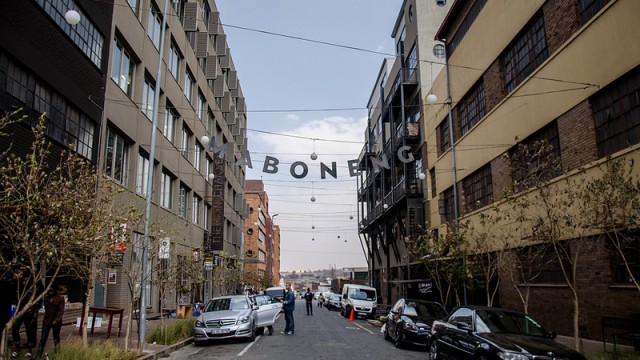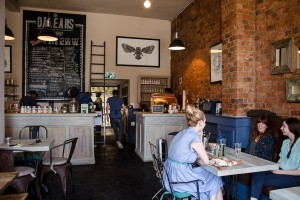A decade ago downtown Johannesburg was a no-go area of high-rise slums, violent crime and streets filled with trash. Now, many parts of downtown are bursting with chic shops, trendy restaurants, cutting-edge galleries and edgy hotels, thanks to young creatives who’ve transplanted from the suburbs and spurred urban renewal efforts. Downtown, which was never high on travellers’ itineraries, is now attracting a new wave of urban tourists.
So how did downtown make such a dramatic transformation? In the 1980s the withdrawal of foreign investment in South Africa led to the movement of businesses out of the CBD, an exodus which continued into the post-Apartheid years and left the inner city to suffer years of urban decay and neglect. That was until a massive clean up operation took place a few years ago, followed by the move by intrepid developers to buy up derelict properties and convert them into student accommodation, loft apartments, offices, restaurants and shops.
On the edge of the Central Business District (CBD), Braamfontein, which is just next to the city’s largest university, WITS, was an easy target for property developers, as there was a serious lack of student housing. A few years ago a property development group created thousands of student apartments from unused buildings and the bars, shops and restaurants have followed. Now, the area has been dubbed the South African version of Brooklyn’s Williamsburg, with designer restaurants offering artisanal food. There’s specialist pizza joint 86 Public, Ramen, a Japanese noodle bar, whimsical eatery Daleahs, deli-style café Love Food and minimalist coffee shops such as Father Coffee and Post that look like they’re straight out of an uber-trendy magazine.
 Saturday is the best day to be in Braamies (locals’ affectionate nickname), when the Neighbourgoods food market, with stalls selling everything from Belgian waffles to gourmet burgers, takes place in a former office block. The hip crowd moves from the market to The Beach across the road, landlocked Joburg’s answer to a sunny day hangout: beach chairs and umbrellas on a sandy rooftop with a DJ and bar.
Saturday is the best day to be in Braamies (locals’ affectionate nickname), when the Neighbourgoods food market, with stalls selling everything from Belgian waffles to gourmet burgers, takes place in a former office block. The hip crowd moves from the market to The Beach across the road, landlocked Joburg’s answer to a sunny day hangout: beach chairs and umbrellas on a sandy rooftop with a DJ and bar.
In terms of nightlife, Braamies has a mix of grungy-cool and upmarket bars and loads of live music gigs. Randlords, an exclusive, swanky bar open mainly for private events, has public openings once a month and offers some of the city’s most spectacular views from its rooftop terrace, while hipster-populated bars Great Dane and Kitchener’s Carvery Bar get going late in the evening and play host to the city’s best known and underground bands and DJs. Late partiers can stay the night at budget contemporary-chic hotels Lamunu and the Bannister across the road: they’re almost the same price as a taxi to a hotel in the suburbs.
Around the same time as Braamfontein’s was gentrifying, another trendy community was forming to the east of the city. Young property developer Jonathan Liebmann returned to Joburg after travelling the world and couldn’t live in the suburbs, so he bought a property in the east of the city in 2009. At that stage this crime-ridden area was made up of disused warehouses, low-rent overcrowded apartment blocks and homeless people on the streets.
It was a brave move by Liebmann, but one that was definitely worth taking the risk for. Over the past few years, his company has invested in the development of several properties in the space of a few blocks, forming an area now named the Maboneng Precinct (“place of light” in Sotho), which has attracting an enclave of musicians, artists and creative who now live and work here. Every second person is a hipster photo opportunity and the whole place feels like a chic-living experiment come to life.
There are funky Brooklyn-style loft apartment blocks, artists’ studios, the Bioscope — a cinema that screens indie films, décor shops and chic boutiques stocking goods from up-and-coming city designers, a yoga center, art galleries, an urban museum and a hotel. The 12 Decades has 12 different rooms conceptualized and designed by different artists, each representing a different decade in Jo’burg’s history. Market on Main, a food, vintage clothes and design market takes place every Sunday, where you can get everything from Indian curries to Ethiopian coffee.
The eateries and shops here have a distinct African influence that reminds you that you’re not in New York, but in Africa. Blackanese Sushi and Wine Bar offers Afro-Asian fusions such as biltong (beef jerky) sushi, and then there’s Sha’p Braai where you eat the South African favorite — boerie rolls (barbecued sausages in hot dog rolls laced with ketchup) — Little Addis, for cheap Ethiopian stews and traditional African food at House of Baobab.
It’s great to spend a weekend hanging out in Maboneng with the city’s coolest urban hipsters, but to really get a feeling for the regeneration of the city as a whole, let former landscape architect and passionate Johannesburg enthusiast Gerald Garner of Joburg Places guide you through the streets on a half-day walk. Gerald offers a range of tours in downtown Joburg, from pub crawls to shopping tours through the Ethiopian quarter of the inner city, where he tells fascinatingly rich stories about Joburg’s history through its streets, monuments and buildings.
Growing up in Joburg’s northern suburbs in the 1990s, I had never set foot in the inner city until I joined Garner’s “Regenerated Inner City Walking Tour.” To say it was eye opening would be a major understatement. It totally changed my perspective on my hometown; in fact it gave me a new-found appreciation for a city I’d never been fond of. Gerald’s walks invariably incorporate rooftops, whether it’s sundowners at the Parktonian (its bar has 360-degree views, the best in the city) or a trip to the top of the 50-story Carlton Center, Africa’s tallest skyscraper, where you’re reminded of New York as you look down over downtown.
Joburg still has a long way to go before the inner city is restored to its former glory from decades past, but the energy and enthusiasm of its new urban citizens is infectious, and more exciting development projects are always on the rise. If you visit Joburg and only see the suburbs, you’re missing out on the beating heart of this dynamic, energetic, constantly evolving city.


